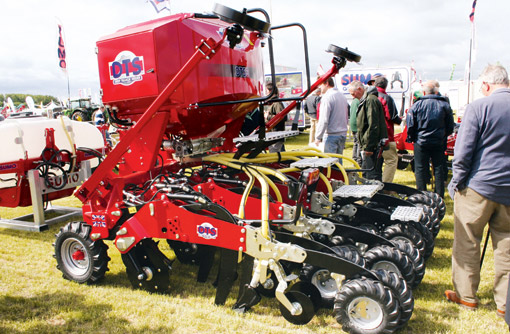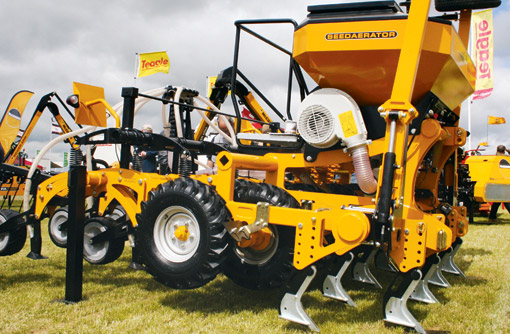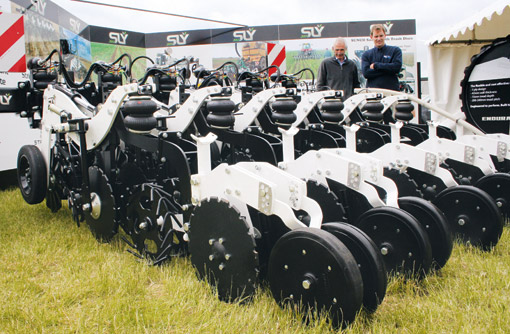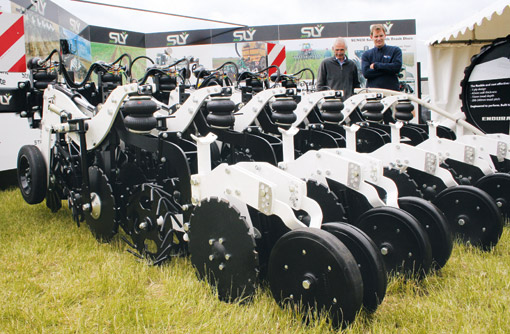Cereals 2013: Growing options for strip till drills

New implement options for strip tillage establishment unveiled at Cereals 2013 provide a daunting choice for growers thinking of adopting this new-to-UK approach.
Equipment from British manufacturers, as well as continental and US implement makers, is primarily geared towards cereal crops or oilseed rape, sugar beet and maize, with a view to reducing energy input and weed germination.
The technique also promotes fertiliser placement and targeted use of slurry and bioenergy digestate for arable crops.
But the flush of new implements also creates a dilemma for growers contemplating a change from a conventional crop establishment system by introducing a further option mid-way between min-till and direct drilling.
“It’s all about trading risk and the level of management required with the potential savings and other benefits that different establishment systems offer,” said Andy Gamble of Väderstad, whose new strip till tine package adapts the Spirit trailed drill to the technique.
“Comprehensive minimum tillage is versatile, generally reliable and offers significant savings over traditional plough-based tillage,” he pointed out. “Direct drilling, with our Seed Hawk machines, for example, is the lowest cost option, but isn’t suited to all soils and needs to be well managed.”
Strip tillage is a one- or two-pass technique that creates a seed-bed but only where it is needed rather than across the entire field. The reduction in soil movement can make significant savings in energy input and encourages natural soil structure improvement by eliminating unnecessary cultivation.
Soil fertility
“Leaving the bulk of crop residue on the surface retains moisture and organic matter,” added Martin Lole of strip drill maker Mzuri. “And it also provides a firm surface for subsequent operations and, over time, increases worm activity and soil fertility.”
Latest UK manufacturers to pitch into the strip tillage market are Sumo and McConnel; the latter is best known in the tillage arena for the long-serving Shakaerator subsoiler/cultivator.
Sumo’s Deep Tillage Seeder made its working debut at the Cereals event in 8m form, with smaller mounted versions from 3m wide featuring among the static exhibits.
All soil-working elements are carried on the same assembly for all models, spaced at 333mm centres and with hydraulic pressure keeping the coulter at a consistent working depth.
A leading disc cuts through trash ahead of an auto-reset soil loosening tine, adjustable to a maximum working depth of 350mm.
Unlike other designs, which have a press wheel following, the DTS tines are positioned immediately in front of the 150mm band-sowing coulter. Twin covering discs follow, then a pair of pneumatic press wheels to consolidate the finished strip.
Lower costs
“Only loosening the ground into which plant roots will grow reduces fuel consumption and steel wear, lowering establishment costs,” said Marcus Ainley of Sumo. “Also, leaving ground in between the rows undisturbed improves the soil carrying ability for following operations.”
The Seedaerator is McConnel’s first seed drill and is billed as a simple mounted design with nine leading low-draft winged tines cultivating ahead of a tyre press/depth wheel and a 150mm band-sowing coulter. A soft press wheel firms the resulting tilth, which is levelled off by a finger tine harrow.

“High ground clearance and wide leg stagger ensure good trash flow,” noted Wayne Brown of McConnel. “We’ve kept the Seedaerator as simple as possible without compromising its performance, but larger and more sophisticated versions are planned.”
The coil spring coulter pressure mechanism is an example of the “simple” approach, and one that McConnel hopes to patent. Pressure is adjusted easily by a handle at the side of the machine, but could be operated hydraulically.
A break-back mechanism for the leading tines will be introduced as an option to suit heavier soils and stone-laden soils.
Field experience with the Pro-Til strip tillage drill has led Worcestershire-based Mzuri to fit hydraulic auto reset tines as standard on the 3m mounted and trailed models, and the 4m trailed machine. A further refinement is the installation of boards to prevent soil being thrown sideways by the band-sowing coulters.
“Soil thrown out is directed back behind the coulters, leaving a cleaner, more uniform finish,” explained Mr Lole. “Together wth our pressurised coulters giving consistent sowing depth, this eliminates any need for rolling, which makes the Pro-Til a true one-pass machine with no need to enter the field again until spraying.”
Strip till units imported from US and Continental manufacturers are aimed at oilseed rape, sugar beet and maize establishment, providing either one-pass targeted seed-bed preparation and sowing or cultivation and slurry application ahead of a separate sowing operation.
“We have customers using the Stripcat system for both techniques,” said George Sly of Lincolnshire-based Sly Agri, whose associate business, Sly Europe, builds the US-originated assembly in France. “We have a Norfolk contractor using the Stripcat for applying digestate from a biofuel plant and a Hampshire farmer planning to establish 600ha of oilseed rape with it this year.”

A cutting disc with depth limiting wheels alongside is followed by angled “trash manager” finger wheels that clear crop residue from in front of the chisel point tine. Discs positioned close alongside prevent soil being thrown beyond the cultivated strip.
To complete the assembly there are crumblers and packer wheels to suit how the implement is to be used, with pneumatic rubber springs providing both down pressure on the parallel linkage and variable pressure on the finishing tool. A single- or two-row sowing kit for oilseed rape can be added.
For precision sowing of sugar beet or of maize for feed or energy usage, the Duro-France strip till unit being imported by Landquip offers a one-pass “till and drill” approach. Adding the optional three-point linkage and hydraulic pto drive to the back of the implement means a precision seeder can be used in tandem.
A small number of growers are already using this technique; they report significant savings in soil preparation, taking no longer to till and sow in one pass than it takes to harrow a seed-bed after ploughing.
They also saw benefits such as reduced moisture loss and risk of wind erosion on light soils in a dry year, as well as the environmental advantages of over-wintered stubbles, said Mr Sly.

The Duro-France unit is more compact than typical US designs that put greater emphasis on trash clearance. Residue clearing finger wheels are positioned alongside the leading straight disc, with a substantial subsoiling tine following.
Plain gathering discs recover soil thrown sideways, liquid and solid fertiliser placement can be added, and a crumbler or steel press wheel finishes the assembly.
There are rigid and telescopic frame versions, plus a folding trailed unit with a bridge-link frame carrying the seed drill for large growers and contractors wanting high outputs cultivating and sowing up to 12 rows at a time.
Keep up to date with all the latest from Cereals 2013
